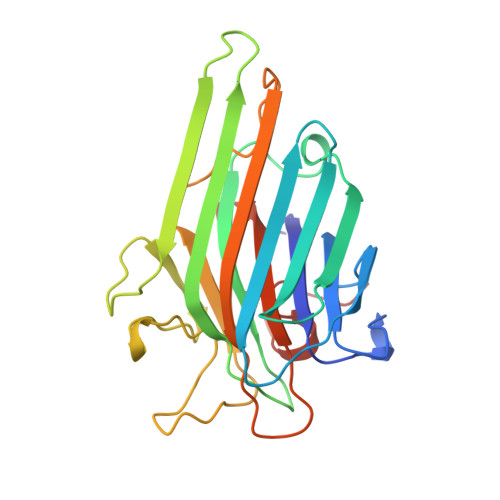The crystal structures of Man(alpha1-3)Man(alpha1-O)Me and Man(alpha1-6)Man(alpha1-O)Me in complex with concanavalin A.
Bouckaert, J., Hamelryck, T.W., Wyns, L., Loris, R.(1999) J Biol Chem 274: 29188-29195
- PubMed: 10506175
- DOI: https://doi.org/10.1074/jbc.274.41.29188
- Primary Citation of Related Structures:
1QDC, 1QDO - PubMed Abstract:
The crystal structures of concanavalin A in complex with Man(alpha1-6)Man(alpha1-O)Me and Man(alpha1-3)Man(alpha1-O)Me were determined at resolutions of 2.0 and 2.8 A, respectively. In both structures, the O-1-linked mannose binds in the conserved monosaccharide-binding site. The O-3-linked mannose of Man(alpha1-3)Man(alpha1-O)Me binds in the hydrophobic subsite formed by Tyr-12, Tyr-100, and Leu-99. The shielding of a hydrophobic surface is consistent with the associated large heat capacity change. The O-6-linked mannose of Man(alpha1-6)Man(alpha1-O)Me binds in the same subsite formed by Tyr-12 and Asp-16 as the reducing mannose of the highly specific trimannose Man(alpha1-3)[Man(alpha1-6)]Man(alpha1-O)Me. However, it is much less tightly bound. Its O-2 hydroxyl makes no hydrogen bond with the conserved water 1. Water 1 is present in all the sugar-containing concanavalin A structures and increases the complementarity between the protein-binding surface and the sugar, but is not necessarily a hydrogen-bonding partner. A water analysis of the carbohydrate-binding site revealed a conserved water molecule replacing O-4 on the alpha1-3-linked arm of the trimannose. No such water is found for the reducing or O-6-linked mannose. Our data indicate that the central mannose of Man(alpha1-3)[Man(alpha1-6)]Man(alpha1-O)Me primarily functions as a hinge between the two outer subsites.
Organizational Affiliation:
Laboratorium voor Ultrastructuur, Vlaams Interuniversitair Instituut voor Biotechnologie, Vrije Universiteit Brussel, Paardenstraat 65, B-1640 Sint-Genesius-Rode, Belgium. bouckaej@vub.ac.be

















